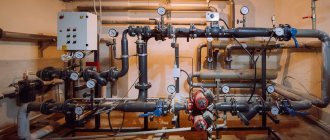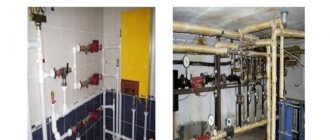Free legal consultation over the Internet 24 hoursLawyer on housing issues in St. Petersburg. Free legal consultation on labor disputes.
5/5 (18)
Who owns the sewer riser
Attention! Initially, we find out who is the owner of the pipeline responsible for the sewerage system. To do this, you need to study the legislation of the Russian Federation currently in force. The Housing Code of the Russian Federation establishes that the pipeline for hot and cold water supply is part of the common property.
Now it’s worth understanding what common property is. Rules for the maintenance of common property of owners and housing complexes of the Russian Federation determine the composition of common property. And it consists of premises owned by local governments and state authorities, but nothing is said about the pipeline responsible for the sewerage system.
Paragraph 5 of the Government of the Russian Federation of May 6 No. 354 will help resolve the dispute on this issue, which explains that the common property includes an engineering system responsible for drainage, which is located inside an apartment building and consists of shaped parts and sewage outlets (crossings, tees, branch pipes, bends and transitions), as well as plugs, drain funnels, risers, exhaust pipes, parts of pipes located between the risers and butt joints, and second equipment located in the system.
Drawing a conclusion from the above, we can say that sewer risers are the common property of an apartment building.
Who should change the sewer riser in an apartment?
The pipeline responsible for the sewerage system is considered community property, which means that its repair and maintenance is carried out by the organization that services the apartment building.
If your apartment is flooded due to a faulty pipeline, you must first contact the service company with a request. If the case is complex and urgent, then you need to contact the emergency service so that the malfunction can be eliminated as soon as possible.
Employees of such organizations must inspect the malfunction and damage caused in front of witnesses and interested parties. All this must be included in the appropriate document (act). This document reflects which apartments were affected by this malfunction, the reason for this, the damaged property, etc.
Remember! When drawing up the report, witnesses and interested parties must be present, so employees carrying out repairs cannot be released. The document indicates the culprit through whose fault the leak occurred.
If the document indicates that the leak occurred because the riser failed, then the management company is considered the culprit. Because the responsibility for maintaining it in proper condition lies with the management company.
Although, if the document indicates the tenant’s fault, that is, he independently replaced pipes or equipment, and thereby caused mechanical damage to the riser, then the responsibility for restoration will lie with the owner of the apartment.
Storm drainage in a multi-storey building. Device. Interior
Have you ever wondered how storm drainage is installed in a multi-storey building, who is responsible for the installation, and who should build this element of communications? We will figure it out together with you in this article.
The amount of precipitation falling on the roof of a house creates a serious danger for residents of the upper floors. In addition, the foundation and basements are at risk. Rainwater needs organized collection and disposal to discharge points. These functions are performed by storm drainage in a multi-story building. It should not be confused with a conventional sewer system. They perform similar tasks, but have significant differences in design and operating mode.
Tasks of storm drainage of a multi-storey building
The main function of stormwater systems is to organize the collection and transportation of rain or melt water. In addition, the complex performs the following tasks:
- protection of soil from erosion;
- cutting off wastewater from contact with the foundation;
- preservation of the building's exterior;
- transportation and discharge of wastewater into drainage tanks.
Storm drainage in high-rise buildings is one of the main life support systems. The absence of a normally functioning system poses a threat to the apartment on the upper floor and contributes to the premature destruction of the load-bearing elements of the structure. The penetration of sewage into the basement contributes to the appearance of mosquitoes and the appearance of a musty smell in the entrances. Storm drainage for an apartment building is a mandatory element of landscaping, prescribed by SNiP and other regulatory documents. Everyone who is responsible for storm drainage must ensure the functionality and good condition of the system.
Design Features
Storm sewer consists of two sections:
Internal storm drainage consists of all elements located on the roof and vertical pipelines through which water moves to receiving tanks. The outer part is a system for transporting wastewater to the rain collector. The composition and design of the external sections are almost the same for all systems. The difference lies in the way water is collected and moved down from the roof.
Houses with pitched roofs
Buildings with sloping roof slopes are equipped with a system of receiving trays installed around the perimeter of the roof. Water flows into them, passes to the receiving funnels, goes down the drainpipes and is directed to the receiving tanks or to the main line. All systems of this type are gravity flow. This means that the installation of internal storm drainage must be carried out taking into account the slope of the trays.
Repair and maintenance of such systems is simple, since there are no hidden elements. However, placing components at high altitudes makes work difficult and makes maintenance or replacement an extremely dangerous procedure. Open trays are often filled with small debris blown by the wind. Blockages quickly increase and become denser, blocking the flow of drains.
If you do not periodically clean the gutters, moisture will overflow and enter the walls and windows of the lower floors. This is the only drawback of such systems.
Flat roof houses
Internal storm drainage in a multi-storey building with a flat roof consists of one or more receiving funnels connected to a vertical pipeline. Another name is a siphon drain. It extends to the ground floor, exits the foundation and joins the main line. To organize efficient collection of water, a slope is made to the funnels. The diameter of the riser must provide sufficient throughput so that rainwater can be removed without delay.
Sometimes a more complex structure of internal siphon systems is encountered. Receiving funnels are connected to horizontal pipelines located under the floor slab. An L-shaped connecting element connected to the riser extends from the horizontal pipes. The principle of operation of the network does not change, the difference is only in design issues.
Repairing a storm drain in an apartment building is greatly simplified if it is assembled using a siphon type. All possible problems involve clogging of the riser. Maintaining, repairing and changing components with this arrangement of elements is much easier and safer.
The design of such systems is based on the general configuration of the building. According to SNiP standards, there is one riser per entrance, or one vertical pipeline per 250 m2 of roofing. It is important to ensure high-quality sealing of all connections, otherwise leaks will occur that destroy the wall material or foundation. The sewer risers of high-rise buildings are common property, so concerns about the condition of these elements fall on the shoulders of management company employees.
You may also like:
Storm sewerage in a private house: design, installation, rules
Drainage and storm sewerage - types and features of systems
Sewerage in the bathhouse: a device, how to make it yourself
Features of the external section of the system
The outer section is either a drainage well connected to the inner section by an underground pipeline, or a connection to the main line. The peculiarity of the operation of these networks is that the load is not constant. Most of the time the internal cavity is empty, which makes it attractive to rodents and insects.
If the installation of the system was carried out incorrectly, blockages will occur. To eliminate this, inspection (inspection) wells are installed along the entire length of the underground part of the pipeline. The distance between them should be no more than 50 m (for pipes with a diameter of 200 to 450 mm). Clearing blockages is a labor-intensive procedure, so external trays are most often used.
Application to the management company
If the owner of the apartment discovers that the sewer riser is in poor condition, he must contact the utility service to replace the plumbing equipment.
There is no strictly defined form for such an application, so it is drawn up in a free form.
Notice! Although the required information for this application is:
- name of the management company and last name, first name, patronymic of the manager;
- proof of timely payment and absence of debt for utilities (payment receipts);
- please replace the sewer riser;
- the applicant's signature and date of application.
The application is drawn up in two copies, one is sent to the management company, and the second with a receipt mark remains with the applicant. After such a statement, CC employees are required to inspect the sewer riser.
As a result of the inspection, a report is drawn up that reflects information about the condition of the riser, and on the basis of this document a decision will be made on its replacement (whether it is necessary or not).
Watch the video. What the management company should repair for free:
How to change?
To replace a riser that has failed or needs replacing, you should contact the management company with an application addressed to its head.
Before writing an application to the Criminal Code, you can call a plumber to your home, who will draw up an inspection report of the sewer riser, document the damage and the need to replace the riser.
Next, you need to draw up an application for replacing the riser in free form addressed to the head of the management company, justifying the reason why the replacement work should be carried out.
At the end of the application, you should write a specific request for replacement or repair of the sewer riser. Next is the date and signature of the owner. The application is drawn up in two copies, one of which remains with the owner, the other is given to the management company.
Read more: Punishment for late payment of traffic fines
Sample application for replacement of a sewer riser.
The homeowner submitting the application must be a bona fide utility payer in order for his application to be accepted and considered.
After reviewing the application, a convenient time for the work is agreed upon with the owner. The riser is replaced by employees of the management company or contractors hired by the management company.
The owner must provide free passage to the bathroom in order for the pipes to be replaced. How much does it cost to replace a sewer riser in an apartment?
additional funds when replacing the riser or branches from it before the first connecting connection.
The approximate cost of replacing a sewer riser in one apartment is from 4 to 7 thousand rubles.
Quite often, homeowners are faced with the fact that management companies demand payment for the replacement of the riser, citing the fact that the riser pipes are located on the owner’s premises and the homeowner is responsible for them .
In such cases, management company employees should be reminded that sewer, water risers and battery risers serving more than one apartment are common property, and the management company is responsible for their replacement and repair.
Moreover, the replacement of risers will in any case be paid for by homeowners from the funds they pay in utility bills .
You can learn what to do if one of the residents of the house is against replacing the common sewer riser from the video:
Didn't find the answer to your question? Find out how to solve exactly your problem - call right now:
It's fast and free!
Over time, various communications in residential buildings become unusable. And a situation may well arise due to a leaking sewer riser. Despite the fact that this problem can arise at any time with any person who lives in an apartment building, very few know the answer to the question: “The sewer riser is leaking: who should repair it?” .
If you want to find out how to solve your specific problem, please contact the online consultant form on the right. It's fast and free! Or call us at 8(800)-350-30-02 (the call is free for all regions of Russia)!
Imagine the following situation. The sewer pipes in your apartment have rotted and started leaking. As a result, your bathroom is flooded and the neighbors below begin to flood. Their apartment turned out to be insured, but they are still going to sue you for compensation for the damage caused.
Naturally, unpleasant questions arise: “Are you the culprit? Do you have to pay full damages? If not, then who should change the sewer riser?” . And the most important question: “Who should have changed the riser in time and at whose expense, so that this trouble would not happen.”
Who is to blame: the owner or the utilities?
In case of flooding of the apartment, an application is submitted to the utility service, and in an emergency, to the emergency service. Employees of these organizations, in front of witnesses and interested parties, draw up a report in which they indicate in which apartments the breakthrough occurred, its cause, a list of damaged property, etc.
The leak report is the main document that establishes its cause and culprit. If the cause of the leak is rotten pipes, then the fault lies with the management company. After all, her direct responsibility is to monitor the proper condition of the plumbing.
If the fault of the apartment residents is established, for example, independent replacement of the pipeline or damage to the riser, then the responsibility for elimination lies with the apartment owner.
Please note that this situation only applies to the case of an insured apartment. Then, in the event of flooding, the owners of the insured apartment contact the insurance company. And the insurers, in turn, issue an invoice for compensation for the damage caused to the person responsible for the leak.
Attention! Our qualified lawyers will assist you free of charge and around the clock on any issues. Find out more here.
Can they sue?
The owners of the damaged apartment can file a lawsuit demanding compensation for property damage. If the culprit is the management company, then it is a co-defendant. And at the court hearing, it will be necessary to prove the guilt of the management company, that the leak occurred through their fault, and the consequence of this was damage to the plaintiff’s property.
At whose expense is the replacement carried out?
It is illegal for owners to write applications to a private organization or want to pay additionally for pipeline repair work. Because all work is carried out at the expense of the owners of residential premises.
The monthly payment for utilities includes a fee for the “maintenance and repair of common property.” The cost of this service is calculated depending on the square footage of the apartment and the number of registered persons.
Important! In accordance with the norms of MDK 2-04.2004, there is a list of works that are included in the cost of rent:
- maintenance of common property;
- maintenance of communication networks;
- work in case of an accident;
- ongoing repair work.
Thus, the cost of all work related to the maintenance and repair of equipment is included in the rent. Therefore, the management company is obliged to replace the sewer riser, even in a privatized apartment, free of charge. This has already been paid for previously.
An exception to this rule is repairs that are required to be made as a result of unauthorized repairs or reconstruction of plumbing equipment by the apartment owner.
If, as a result of these actions, other owners of residential premises of an apartment building suffered, then compensation for the damage caused will also be carried out from the wallet of the culprit.
Sewage device
In order to understand how sewerage works in a city, you first need to consider the structure of the city's sewerage system. The city sewerage system includes a number of utilities responsible for the disposal, purification, and recycling of wastewater.
Sewerage is divided into three types, depending on the type of wastewater:
- Household (K1).
- Storm water (K2).
- Production (K3).
In general, the city sewerage system is no different from the local sewerage system of a private home. An important feature of how the city sewerage system is structured is the system for the movement of household waste within it. As with the construction of a local sewerage system, the movement of wastewater occurs naturally due to the creation of a slope, although in some cases the use of fecal pumps is required. The key difference is the length of the pipeline and the capacity of the treatment facilities.
In fact, street sewerage includes:
- Pipes that drain wastewater from residential buildings and industrial premises.
- Sewage wells (the main ones are located near apartment buildings).
- Sewage pipes.
- Key outlet lines.
- Collectors.
- Fecal pumps.
- Air stations.
It is the aeration stations that are the place where city sewage drains from all areas of the city.
At the station, household waste is decomposed in special containers under the influence of reagents and bacterial additives.
Responsibilities of apartment owners
In accordance with current legislation, the decision to carry out major repairs is made by all owners of residential premises in an apartment building. But you cannot do this yourself.
Apartment owners only service equipment located directly on the property, in the apartment.
And to carry out major repairs of common property, a management company is hired, which hires contractors to carry out the work if it cannot do it on its own.
Replacement
We must not forget that in addition to the right of ownership, there is also the so-called burden of the owner, which lies in the need to maintain his property in working condition and pay for its repairs. Including for: water; sewerage; gas; other blessings of the world.
And here an important question arises: who is considered the owner of those pipes and their branches, which are no longer located inside each private territory, but connect it with utilities that supply liquid, heat and light to the structure itself? They, as it became clear, are classified as general property that belongs to everyone.
ATTENTION! It turns out that the pipes in the apartment are personal, and the risers are shared.
According to the rules, the owner’s responsibilities for making decisions about the need for routine and, especially, full repairs lie with all apartment owners. Owners of housing and common property must: ensure the stable technical condition of general communications; decide to update them if such a need arises.
Read more: Agency agreement for real estate rental
But the owners themselves can only repair the equipment that directly serves their home. After all, it is their personal property.
To repair general communications, they transfer some of their personal responsibilities to a management company, which resolves all complex problems for them. This agreement is official, that is, it implies the transfer of a specific amount monthly.
Such financial transactions are also the responsibility of the apartment owner. In return, he is provided with high-quality services for the entire farm.
Responsibilities of housing and communal services. Carrying out all repair work that is required to maintain the risers in the apartment, sewerage, heating and others in working technical condition, all this is considered the responsibility of the housing maintenance office . Or another company with which an official contract was drawn up.
The basis for carrying out the manipulation will be: a plan for their implementation; an act stating that any part of the riser needs to be updated to prevent an accident; occurrence of a leak or other problem. If something is leaking, you should have your housing and communal services repaired in any case.










